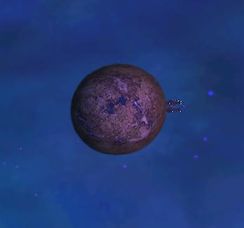
|
This wiki is closed in favour of the new wiki. Information shown is likely to be very out of date. |
Planet Kitahara
Error creating thumbnail: Unable to save thumbnail to destination
|
This page has been retired but kept for historical or other reasons, The information on this page may be incorrect, out of date or just not relevant to this version of Discovery. It should not be taken as canon nor any authority on the current version of Discovery. It is kept simply to show some history of the Discovery Mod:
See also:
|
| Planet Kitahara | |
| Location | 6G, Tau-65 Edge Worlds |
| Technical information | |
| Docking | No |
| Terrain | Terrestrial |
| Diameter | 13,512 km |
| Mass | 6.20 x 10e24 kg |
| Temperature | -22°C to 32°C |
| Escape velocity | 12.60 km/sec |
Originally charted in 655 A.S. by the Golden Chrysanthemum exploration vessel Hikki Maru, the planet Kitahara was noted for its extreme similarities to Malta, even down to a virtually identical climate and atmospheric composition. Fully habitable with a comfortable surface pressure and an atmosphere that is well within the tolerable limits for human respiration, the planet was eventually settled by large numbers of the Sisterhood and their families in 678 A.S., with farms and homesteads becoming commonplace across the planet after only a few years.
Substantial deposits of iron, aluminium and niobium were discovered in the Okimura mountain range on the northern continent by several Blood Dragon planetologists, although it was not until 723 A.S. that mines were opened to take advantage of the availability of these resources. Initially the work was done by robotic mining machinery and human overseers, but as more prisoners were captured during fights against the Kusari Naval Forces, Farmers Alliance and the Hogosha, they started to be put to work within the mines. Captured female prisoners were either inducted into the Golden Chrysanthemums if suitable or sold off to the Outcasts and Blood Dragons in exchange for Cardamine and supplies.
By 766 A.S., the planetary population was estimated to have reached at least twelve thousand. The majority of the inhabitants were still members of the Sisterhood, but a significant number were also Blood Dragons by now, who had relocated from Kyoto Base to a more pleasant planetary environment after having grown weary of living in space. The Blue Lotus Syndicate even constructed a number of offices and warehouses within the capital city of Yomi, to serve as a base to which to ship Cardamine to the Golden Chrysanthemums, all the way from Malta.
In 805 A.S., after a convention held in Yomi by many eminent Golden Chrysanthemum and Outcast scientists, it was decided to attempt to seed Kitahara with Cardamine. The planetary conditions were largely ideal and very similar in many ways to Malta itself, so it was widely believed that Cardamine could indeed be grown on Kitahara. Experimental plantations were set up the following year, but unfortunately most of the seeded Cardamine initially died out due to inexperience by Sisterhood farmers in cultivating the grasses. By 809 A.S., the Cardamine did manage to take hold in a few areas, but the yields were of horrendously poor quality compared to the Cardamine from Malta, but there was a severe side-effect to the meddling in the planet's ecosystem. The influence of the Maltese orange grass on Kitahara's ecology had begun killing off almost all other native and important crops and with the planetary population in excess of thirty thousand, starvation was looking to be a serious prospect. Many Blood Dragons also became appalled at the Cardamine experiments occurring on the planet and began moving off-world once more, most returning to Kyoto Base, while others moved to the Ryuku and Mito bases.
To counter the potential starvation issues, the Golden Chrysanthemums have since embarked on the ambitious Chanai Biodome Project, covertly aided by Synth Foods, Inc., while at the same time continuing the Cardamine experiments on Kitahara with the Blue Lotus Syndicate. The Cardamine experiments have drawn considerable interest and outrage on Malta, with many Outcast Dons arguing amongst themselves on the viability and threat of such an undertaking. Some argue that it provides the Outcast people with a fallback safety net should Malta ever be nuked by the Corsairs, while others feel that it undermines their ability to effectively control the entire Cardamine market within the Sirius sector. Nevertheless the Blue Lotus Syndicate, an influential Outcast organisation by its own merits, maintains its support of the venture and has a sizeable presence on the planet.
